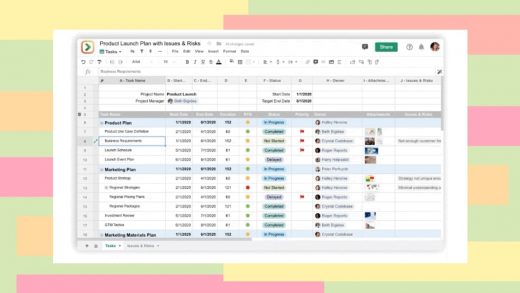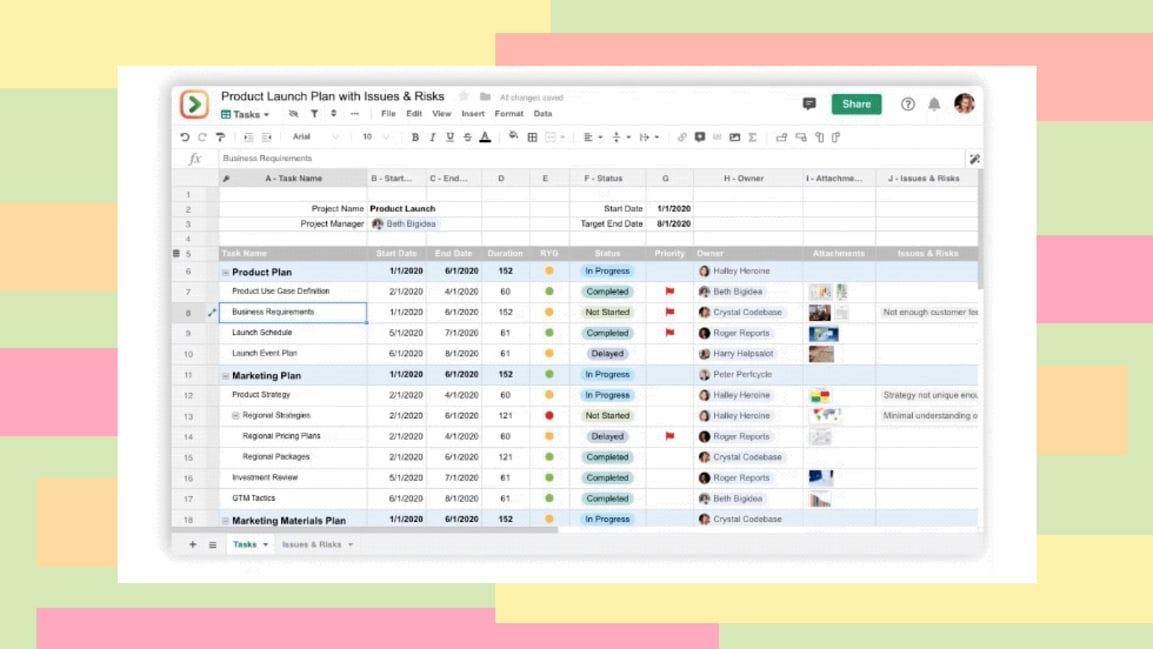Move over, Excel and Google Sheets. Meet the spreadsheet of the future
When you stop and think about it, you don’t hear the words “spreadsheet” and “exciting” in a sentence together terribly often.
And it’s no wonder: Spreadsheets are useful. They’re familiar. In some instances, they’re even essential. But they’re kind of like the Black & Decker toolboxes of the digital business world: They organize your stuff and make it easy to find what you need (provided you can sift through the ever-present clutter, that is)—but ultimately, they’re utilitarian. You use them because you have to, because they get the job done, and you carry other tools alongside them to handle more advanced forms of work.
Matt Robinson wants to change that. Robinson—who founded both Recruitforce, an applicant-tracking service that’s now a part of Oracle, and Rollbase, a custom application creation platform that was acquired by Progress Software—sees the spreadsheet as something that should be embraced and built upon, not treated as a legacy necessity that’s kept separate from more modern business applications.
“Over the years, we found that spreadsheets were kind of our competition,” Robinson says, noting that the vast majority of customers signing up with his previous companies weren’t coming from competing software services but rather from apps like Google Sheets or Microsoft Excel. The more he thought about this trend—and the fact that, according to his research, spreadsheets are used by a hundred times more people than any software-as-a-service platform—the more he realized there was an opportunity waiting to be seized.
That’s why, three years ago, Robinson set out to create Spreadsheet.com, a new project management tool that’ll welcome its first users this winter (and that brings to mind a mostly bygone era of web addresses doubling as company names). The service takes the time-tested spreadsheet and aims to transform it into something new—something modern, something powerful, and maybe even something exciting.
Going beyond the grid
The best way to describe Spreadsheet.com is as a mashup between a traditional spreadsheet, à la Sheets or Excel, and a more advanced database or project-management service like Trello or Basecamp. You bring in any sort of data you want, including financial records, product launch plans, employee databases, and even full-fledged CRM worksheets. Then, similar to what’s offered by services such as Smartsheet and Airtable—with some new twists we’ll explore more thoroughly in a moment—you gain the ability to manage it in a contemporary and collaboration-friendly environment with lots of added bells and whistles.
Let’s say, for instance, you used a worksheet for tracking applicants at your organization. Instead of just having a static spreadsheet with rudimentary methods of data input, Spreadsheet.com would let you do things like drag and drop documents into fields and have clickable thumbnails appear instantly; create a column with a clickable five-star rating system for scoring applicants; create your own custom dropdown menus for setting applicants’ statuses; and assign applicants to members of your team with simple @-tagging.
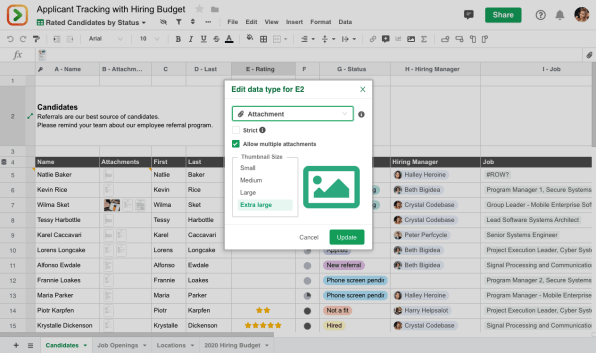
[Screenshot: Spreadsheet.com]
These are all things people try to accomplish in traditional spreadsheets, Robinson says—but they’re forced to accomplish them in roundabout, clunky ways because traditional spreadsheets simply aren’t built for those sorts of purposes. With Spreadsheet.com, Robinson’s goal is to eliminate the need for workarounds and instead provide a framework in which such features are readily available, easy to use, and native-feeling in nature.
“In a typical modern business application, you don’t just get text and numbers,” he says. “You get things like user selectors and dropdown lists that are just much easier to manage.”
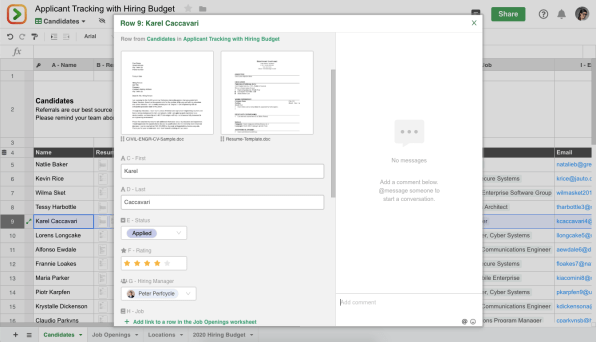
[Screenshot: Spreadsheet.com]
Spreadsheet.com also provides an optional Kanban view—which transforms your spreadsheet into a drag-and-drop card-style format, similar to what you’d encounter in Trello—along with the ability to link rows from one worksheet to another so you can edit data in one place and then have it automatically update anywhere else it’s referenced. And it provides a native, Slack-like messaging experience, with channels built into every row and an app-wide system for notifications.
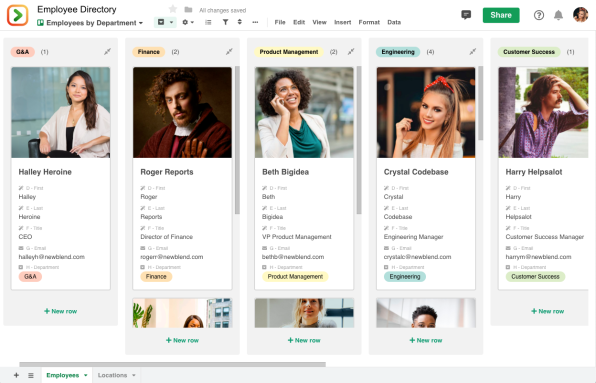
[Screenshot: Spreadsheet.com]
Robinson says Spreadsheet.com’s feature set will expand further too, with plans to add in calendar and Gantt chart views as well as advanced automation options (in the same vein as Trello’s Butler system) and integrations with a variety of external services—ranging from Salesforce and Slack to Microsoft Teams and even Zapier.
Inspiration vs. foundation
So back to the inevitable Smartsheet and Airtable comparison. Robinson noticed something interesting about those applications: They looked like spreadsheets and emulated many of the elements of spreadsheets, but they weren’t technically spreadsheets, in a fully functional sense—and that meant customers were forced either to keep using apps like Sheets or Excel alongside them or to accept a compromise. And that’s where he hopes Spreadsheet.com can stand out.
“When people move from a spreadsheet to those applications, they have to sacrifice all the flexibility, function, and power that’s in the spreadsheet,” Robinson says. “We want to give them their cake and let them eat it, too.”
To that end, every Spreadsheet.com database is actually a standards-compliant spreadsheet at its core. And that means in addition to all of the more project-management-oriented options, you have the same formatting and function tools you’re accustomed to using in Sheets or Excel; in fact, Spreadsheet.com supports some 400 formulas with identical syntax to what’s present in those traditional spreadsheet programs. (Smartsheet, for comparison, currently supports 84 formulas, while Airtable offers 91.)
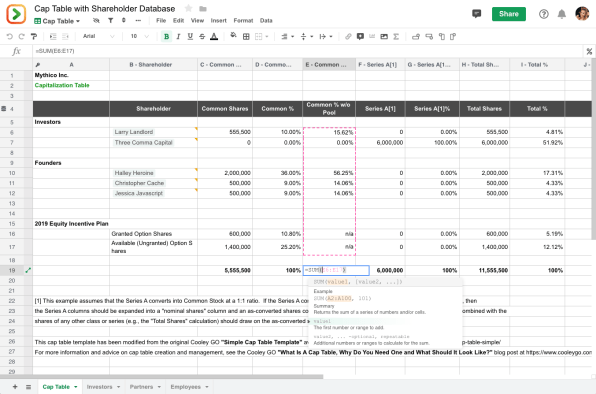
[Screenshot: Spreadsheet.com]
And, crucially, everything you do within the service translates back into a standard XLSX spreadsheet format—so in addition to being able to invite someone to view and optionally edit a worksheet within the Spreadsheet.com interface, you can always export a worksheet and know it’ll be compatible with Sheets, Excel, or any other traditional spreadsheet program. Obviously, some of the Spreadsheet.com specialty elements won’t carry over into those environments, but the service will automatically convert any such items into the closest plain-text equivalents.
So while other services use the spreadsheet as their inspiration, in other words, Spreadsheet.com uses it as its foundation—effectively creating a souped-up version of the spreadsheet instead of trying to replace it with a completely new standard.
“You can have all the power of these purpose-built applications without ever leaving your spreadsheet,” Robinson says.
The current plan is for Spreadsheet.com to open its doors to early adopters sometime this winter—you can request access here—and then to launch publicly somewhere around the middle of next year. The company has plenty to accomplish in the meantime, including the completion of its currently-under-development mobile apps and the plotting of its offline-capable desktop apps, which are expected to arrive at some point later down the line.
Perhaps most critically, though, Robinson and his crew have to convince potential users that, yes, spreadsheets can be exciting—and can be so much more than the static grids we’ve long accepted.
(48)

